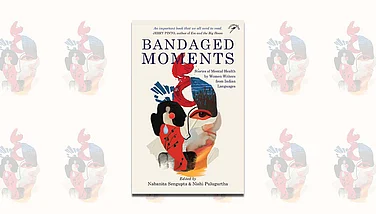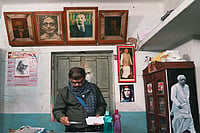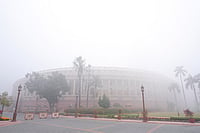Surprisingly, there are few Indian books on studio pottery and practice, and this volume will help fill a lacuna. Gurcharan Singh's 1979 Pottery In India, now out of print, is a charming and compelling mixture of the historical, technical and personal anecdotal. The strength of the earlier book was in its first person narrative, philosophy of clay, mixed with technical expertise of materials and kilns in the Indian context. In rewriting the text, Anuradha Ravindranath and Anupa Lal have tried to mix reportage, technical information, quotations and sentiment, a difficult combination at the best of times, in a text that cannot decide whether it aims to be a coffee-table type of book or a technical one. It turns out to be a bit of both, with some of the technical ceramic text being simplistic and amateurish.
However, the production values of the present book are high, and make it a visual treat. Gurcharan Singh, in his earlier book, regretted that he could not include colour reproductions because of the prohibitive cost involved. This does not seem to be a problem in the present publication; in fact, there could even have been more control exercised in the choice and quantity. Photographer Shailan Parker was clearly not informed on the difference between photographing ceramic pots for a product shoot for cookery and women's magazines, and photographing ceramics as art. One looks for form and profile, glaze and textural qualities in such a book. The 'product shoot' approach, however, works well for the evocative cover photograph, and for some of the collage centre spreads.
The first two chapters are the strongest part of the book. The first, titled 'An Ancient Craft', combining an archaeological and historical point of view, starts with the pre-Harappan period and traces the growth and proliferation of the unglazed clay tradition. The beginnings of architectural glazed tiles on tombs and mosques from the eighth century onward are a direct link of the persian blue glaze that so inspired Gurcharan Singh.
A critical look at Gurcharan's work will show that he actually survived financially on the small-scale handmade production work of glazed bricks, tiles and jalis, rather than on art pottery. It could have been a fascinating study of how he managed to work in both worlds, of production and small-scale industry, and that of the individual, handcrafted pot in India where there is ingrained prejudice towards the potter as a lower caste craftsman.
Gurcharan, through his contact with Yanagi, Leach, Hamada and Tomimoto, the protagonists of the Japanese and English art/craft revival and debate, was at the right place at the right time in 1919, and he imbibed from these men their beliefs of a new craft activity that was centred in a rejection of western industrial capitalist values. From them, he also learnt to look aesthetically at the 'Oriental' style of pottery, as opposed to his own tradition, and to try to achieve and emulate these qualities in his work. To his credit, Gurcharan always kept in mind his own traditional Indian forms, the lota, kulhar, surahi and hookah, from which he derived much of his work.
The second chapter, 'Pioneering Potter', is a dip into Gurcharan's life—the major events and people that shaped him and his art. His experiments with kilns and fuel seem to have been omitted. This is surprising when even the renowned Olsen and Rhodes's kiln books mention Gurcharan's round coal kiln and his firing methods. His substituting kanch, glass powder, for commercial frit and marble chips for whitening are brilliant examples of his adaptation of Western ceramic materials and glaze recipes to Indian realities.
The third chapter, 'The Art of Making a Clay Pot', disappoints by not tackling the actual processes Gurcharan went through at the Delhi Blue in both low and high-fired techniques. The legacy of Gurcharan Singh lives on in his son and studio partner, Mansimran and Mary Singh, at the Andretta Pottery in Kangra Valley, where they now work with the local red clay. All the relevant production stages could have been studied there. Sure, there are a few examples of this, but much more could have been gained for the pottery student by actually focusing on these details, rather than suddenly lapsing into a basic how-to book.
One final, minor grouse. The profile of the seven senior Indian potters lacks connection with the rest of Gurcharan's story. I would have liked to have been told how they come into contact with him to be deemed bearers of his legacy.


























